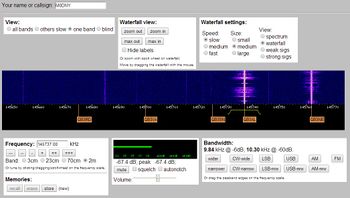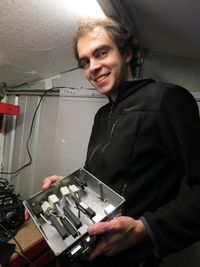WebSDR Newsletter Article March2014
WebSDR is a piece of software that serves the received radio spectrum to many users via a web page, providing a wide waterfall view and giving users the ability to tune around independently and listen to signals that they're interested in. It's a great tool for education of newcomers to radio, as well as monitoring of propagation and listening through to your own signals.
There are many existing WebSDR installations, including the flagship site set up by the Software Author, Pieter PA3FWM in the Netherlands, accessible at websdr.ewi.utwente.nl:8901. The flagship site however, in common with nearly all the other installations, only covers HF bands. This is mainly due to decent topographical positioning being far more critical on the higher frequency bands.
With this in mind we believed that the University was in a unique position to provide an installation on the roof of one of the taller buildings, run by the Wireless Society. After getting hold of a copy of the software and setting it up on a PC to try it out, we began enquiries, but for each of the buildings we were denied roof access due to H&S concerns.
The turning point came after contact with Noel G8GTZ up in Basingstoke, who runs a remote [D]ATV station from a shed at the top of a hill, with fantastic line of sight out to the horizon from North clockwise through to South-West. Noel was interested in a WebSDR installation for use in the Microwave bands, but didn't have the Linux computer expertise to get it running. We also heard from Martin G8JNJ who was interested in setting up one to cover some of the LF bands. This gave the opportunity for us to work together on the project.
The SUWS Websdr, accessible at websdr.suws.org.uk, now supports 2MHz-wide bands at 144MHz, 432MHz, 1296MHz and 10368MHz. A custom shielded enclosure houses the RTL-SDR receiver for each band, each of which has been modified to shield the RF input stage from the USB interface. An array of pre-amps and filters are used to boost the RF signals up into the RTLSDRs limited dynamic range, and to prevent strong signals on neighbouring channels such as PMR from affecting the sensitivity.
The WebSDR recently featured in Southgate ARC News and on AMSAT-UK after it was used to receive some of the first signals from the Lithuanian Cubesat LitSat-1 on the 144MHz band. The WebSDR is used regularly by the LitSat and Funcube teams as a quick and easy receiver to monitor the downlink.
Helical dipole antennas for 144MHz and 432MHz built by Martin G8JNJ have recently dramatically improved the cross-polarisation performance, allowing reception of both FM and SSB stations, as well as satellites, from a single antenna.
Work is continuing, we are planning to add another receiver on 3.4GHz as soon as the new java-free version of the software is released, and we're looking at the possibility of moving the WebSDR to a new shed+mast further up the hill to further lower the noise floor (and the shed temperature in the summer!).
Web Address: websdr.suws.org.uk
More details and photos: WebSDR Wiki Page



